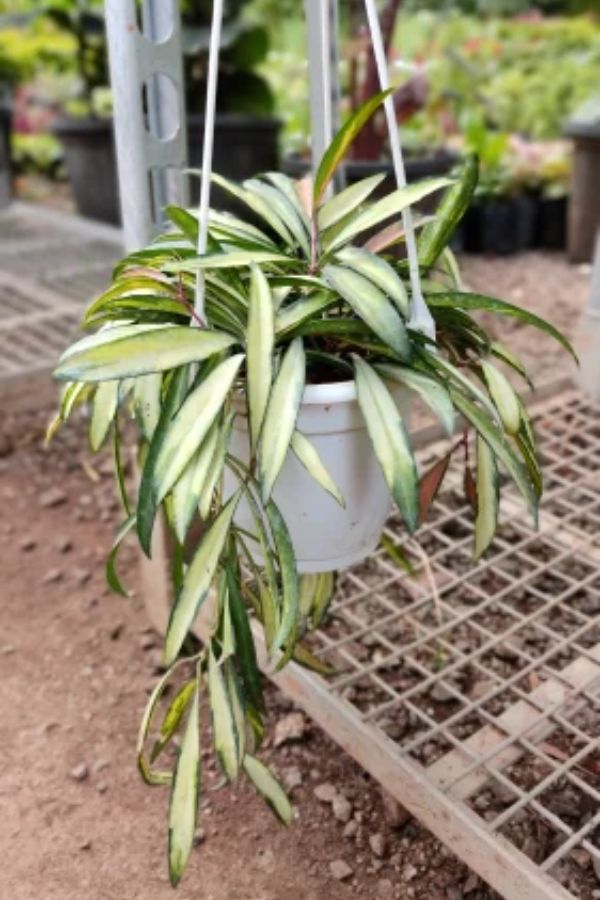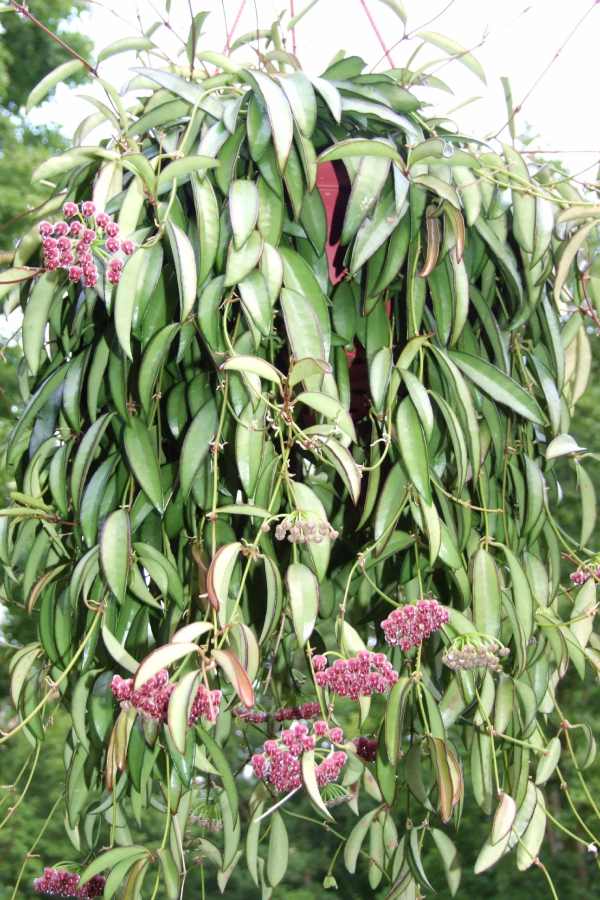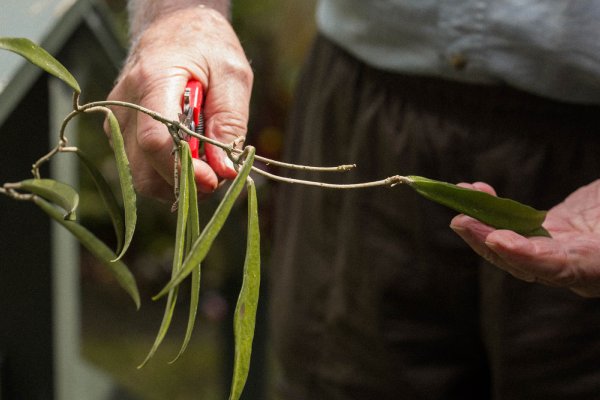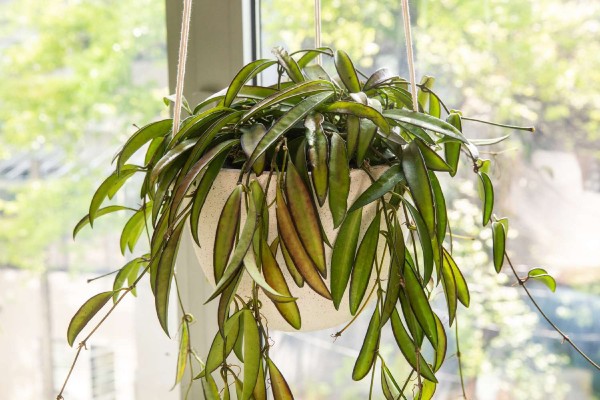Hoya Kentiana is an indoor plant that belongs to the genus Hoya. It has dark green slender, almost string-bean-like leaves. The most attractive feature of this plant must be the reddish purple-colored flowers it produces. These flowers are fluffy, ball-shaped clusters adorned with a darker crown and backward-bending, reddish-lilac petals. This night-blooming species attracts night-time pollinators like bats and moths with its sweet, sugary-scented nectar. Hoya Kentiana is a tropical plant native to Southeast Asia, and it is often confused with Hoya wayetii and Hoya shepherdii due to their similar appearances.
Here we have provided a detailed guide on how to successfully grow and care for your Hoya Kentiana.
Plant Descriptions
Plant Type: Perennial, Vine
Scientific Name: Hoya Kentiana
Family: Apocynaceae
Common Name: Hoya, wax plant
Genus: Hoya
Season: Spring, Summer
Native Area: Southeast Asia
Toxicity: Non-toxic
How to Care for Hoya Kentiana?
Light
Hoya Kentiana thrives in bright, indirect light. However, avoid direct sunlight as it can damage their delicate leaves. If you are growing inside, place the plant in a south-facing or west-facing window. Use a sheer curtain to filter the sunlight. Similarly, during summertime, the plant should be adequately shaded to prevent it from the intense sun.

Soil
Hoya does very well in a rich, well-draining soil mix that is chunky and full of organic materials such as peat moss, orchid bark, perlite, and vermiculite. These organic materials help create a porous soil structure providing good drainage and air packets for oxygen.
Water
Hoya plants need regular watering to keep their leaves vibrant. Be sure to check for moisture every week by sticking your finger in it. During fall and winter, allow the soil to dry out completely between watering.
Temperature and Humidity
Hoya plants prefer warm and humid environments. Place the pot in a place where there is a temperature of 65 to 80°F. Most Hoyas will require at least 50% humidity, but some might require 60% to 70%. To increase humidity, you can use a humidifier or place the plant in a grow tent or glass cabinet to retain moisture. They thrive when the air moisture is high.
Fertilizer
Fertilize your Hoya every month during the spring and summer. You can use a well-rounded houseplant fertilizer with a slightly higher content of nitrogen, but make sure to dilute it to half its strength every four to six weeks. However, stop fertilizing in the fall.
Pruning
Pruning will keep your Hoya plant tidy and encourage healthy growth. Remove dead or damaged leaves and trim back the plant if the vines are growing too long. However, avoid cutting off spent blooms, as flowers will bloom again from those growths the following year.
Pests and Diseases
Hoya Kentiana can attract common houseplant pests such as aphids, mealybugs, and scale. So, check your plant regularly, and if you see these pests act quickly to stop them from spreading. You can use a cotton swab with rubbing alcohol to remove them or wipe them off with a mix of horticultural soap and water.

Propagating Hoya Kentiana
Hoya can be easily propagated through cuttings of the stem. The best time to start this process is early summer when the plant is in an active growth period. Here is a step-by-step guide to help you successfully grow new plants:
- Select a healthy, pest and disease-free stem from the mother plant. Now, take a cutting 4 to 6 inches in length. Then remove the leaves from the lower half of the cutting, leaving at least two leaves at the top.
- Dip the cut end of the stem into rooting hormone powder to encourage root development.
- Take a pot and fill it with a good draining potting mix mixed with organic matter. Water the soil to be consistently moist.
- Next, plant the cutting to that pot and wrap the top of it in a plastic bag to create a humid environment. Keep the pot in a place where the temperature is at least 70°F, or above.
- Again, pick some warm spots with bright, indirect light for its healthy growth.
- After a few days, you might see new leaves growing. Transfer it to a larger pot once the cutting has rooted, and continue further care.
Common Problems with Hoya Kentiana
Hoya Kentiana’s leaves might wrinkle if you water them too much. The plant prefers the soil to dry out almost completely between watering. However, letting it stay dry for too long can damage the roots and make it harder for the plant to absorb water. So, always check the soil before watering and water thoroughly until you see it draining from the bottom. Further, low humidity can also cause the leaves to wrinkle. In that case, you can regularly mist your plant or use a tray with gravel and water to increase the moisture.

Older leaves naturally fall off the plant. However, if you notice a lot of leaves dropping suddenly, it could be a sign of problems with watering, light, humidity, or temperature. Additionally, hoyas usually need to have reached a certain age to bloom. Some will bloom in a few years, while others might take five to seven years. This will most likely be the case if your Hoya is not flowering because of overwatering, too much light, or even poor fertilizing, especially during spring and summer. Do not prune its long vines as well if you would like to see it bloom.
Conclusion
In conclusion, Hoya Kentiana is a beautiful indoor plant known for its dark green, slender leaves and distinctive reddish-purple, ball-shaped flowers. It is native to Southeast Asia. This non-toxic vine plant thrives in bright, indirect light and requires a rich, well-draining soil mix. Similarly, it enjoys warm, humid conditions and regular watering while keeping it dry out between watering periods. Regular pruning and monthly fertilization during the growing season help maintain its health and encourage flowering. With proper care, Hoya Kentiana can be propagated easily and adds beauty to any indoor space.
Frequently Asked Questions
1. What is Hoya Kentiana?
Hoys Kentiana is a tropical indoor plant from the genus Hoya. It is known for its dark green, slender leaves and distinctive reddish-purple, ball-shaped flowers. It is native to Southeast Asia and is non-toxic.
2. How much light does Houa Kentiana need?
Hoya Kentiana thrives in bright, indirect light. However, avoid direct sunlight as it can damage the leaves. If you are growing the plant inside, place the pot in a south-facing or west-facing window with a sheer curtain to filter the sunlight.
3. How often should I water Hoya Kentiana?
Water your Hoya plant regularly while keeping it dry out between watering periods. During fall and winter, you can reduce watering frequency.
4. How do I fertilize Hoya Kentiana?
Fertilize with a general houseplant fertilizer throughout the spring and summer months. Dilute to half its strength and stop fertilizing in the fall.
5. How can I propagate Hoya Kentiana?
Propagate through stem cuttings in early summer. Take a 4 to 6-inch cutting, remove the lower leaves, dip the cut end in rooting hormone, and plant it in a moist, well-draining soil mix. Keep it in a warm spot with bright indirect light.
